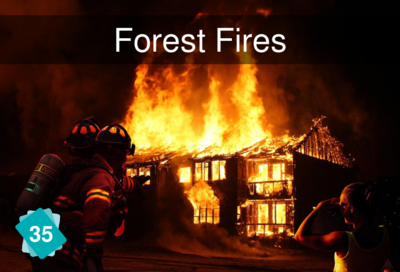En-en adult card 35 forest fires: Difference between revisions
No edit summary |
(move 35->38 to valid lingk) |
||
| (2 intermediate revisions by one other user not shown) | |||
| Line 1: | Line 1: | ||
== Card #35: Forest Fires == | |||
| | <center> | ||
[[File:En-en_adult_card_35_front.png|400px]] | |||
Forest fires start and spread more easily during droughts and heatwaves. | |||
</center> | |||
== Correction== | == Correction== | ||
===Causes=== | ===Causes=== | ||
* [[En-en_adult_card_30_droughts|Droughts]] | * [[En-en_adult_card_30_droughts|Droughts]] | ||
* [[En-en_adult_card_36_heat_waves|Heat Waves]] | * [[En-en_adult_card_36_heat_waves|Heat Waves]] | ||
=== Consequences === | === Consequences === | ||
* [[En-en adult card 38 human health|Human health]] 630 people died in Californian wildfires in autumn 2018. | |||
== Other possible links == | == Other possible links == | ||
=== Other | === Other consequences === | ||
[[En-en adult card 6 deforestation|Deforestation]] | * [[En-en adult card 6 deforestation|Deforestation]] Deforestation is partly done by burning the forest, which can then degenerate into uncontrolled fire. This is what happened in the summer of 2019 in the Amazon and Australia. | ||
* [[En-en adult card 10 aerosols|Aerosols]] Smoke from wildfires has been shown to carry toxic particles. | |||
* [[En-en adult card 25 terrestrial biodiversity|Terrestrial biodiversity]] This is a more minor link, except for specific biodiversity-rich areas. | |||
* [[En-en adult card 32 decline agricultural yields|Decline of agricultural yields]] Generally forests burn better than wheat fields. | |||
== To go further == | == To go further == | ||
Latest revision as of 08:43, 3 November 2021
Card #35: Forest Fires
Forest fires start and spread more easily during droughts and heatwaves.
Correction
Causes
Consequences
- Human health 630 people died in Californian wildfires in autumn 2018.
Other possible links
Other consequences
- Deforestation Deforestation is partly done by burning the forest, which can then degenerate into uncontrolled fire. This is what happened in the summer of 2019 in the Amazon and Australia.
- Aerosols Smoke from wildfires has been shown to carry toxic particles.
- Terrestrial biodiversity This is a more minor link, except for specific biodiversity-rich areas.
- Decline of agricultural yields Generally forests burn better than wheat fields.
To go further
Mega-Fire
A Mega-fire is an exceptionally large fire, causing large local fires that devastate expansive areas, without this appellation corresponding to a very precise scientific definition. We usually speak of a mega-fire when the affected area is at least 1,000 to 10,000 hectares. Mega-fires account for only 3% of all fires, yet represent 50% of global losses[1]. 96% of the last 500 mega-fires in the last 10 years took place during a period of abnormally high heat and/or drought[2].
Examples of events
In 2018, in California, 1,975,086 acres (799,200 hectares, about the size of Corsica) were burned, for a total of 8,000 fires and 100 casualties, but the burned area doubled in 2020 to reach 1,635,300 hectares (larger than Ile-De-France: the greater Paris area)[3].
In the 2019-2020 season, Australia saw a total area of 17 million hectares go up in smoke[4]. This surface area represents a third of France.
Forest fires on Mount Kilimanjaro on the rise[5].
Forest fires on the rise in Portugal and Greece[6]
Article(s)
Fire the Earth, on the mega-fires (French)
References
- ↑ Joelle Zask, When the Forest Burns: Thinking about the New Ecological Disaster (French)
- ↑ United Nations Are "megafires" the new standard? (French)
- ↑ 2020 Fire Season, Cal Fire
- ↑ Government set to revise total number of hectares destroyed during bushfire season to 17 million
- ↑ AR5 WG2 IPCC, low confidence, major contribution from climate change
- ↑ AR5 WG2 IPCC, low confidence, major contribution from climate change
